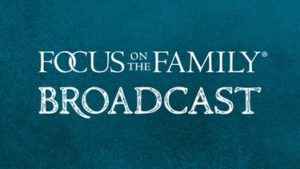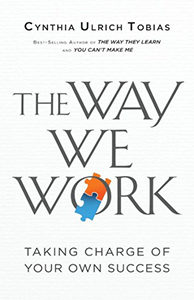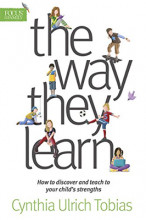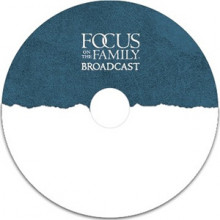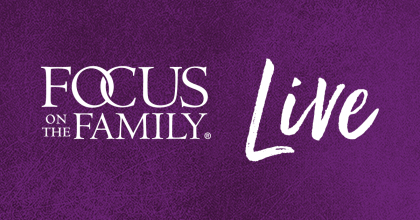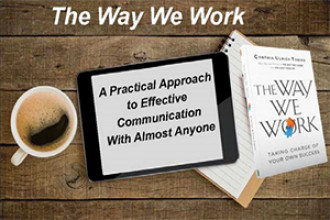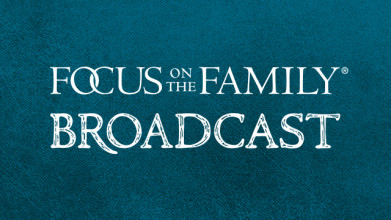Opening:
Excerpt:
Cynthia Tobias: Did anybody else out here marry somebody opposite of you, almost completely opposite? Did you think it would be a refreshing perspective? (laughter) Have you noticed on a day-to-day basis, no matter how much you love that person, it’s not that refreshing? (laughter) Primarily because we are living proof that our way works. Why would I want to do it your way if I already know my way works?
End of Excerpt
John Fuller: I appreciate that perspective. We’re taking a lively look at learning styles, and how they impact your relationships….your host is Focus on the Family President Jim Daly, I’m John Fuller.
Jim Daly: Our guest, Cynthia Tobias, really has a knack for explaining how our ‘cognitive style’ affects how we take in, and process, information, and I’m sure many of you read her classic book, The Way They Learn, to help your children in school. It was a big seller. Now she’s applying that research to adults, to help us improve our marriages, friendships, and work relationships.
And if you missed part one of Cynthia’s presentation yesterday, please get in touch with us. We can send you the entire message on CD or audio download. Or you can get the Focus on the Family broadcast app for your smartphone.
John: You’ll find all of these ways to listen at focusonthefamily.com/broadcast or call us and we can tell you more, 800-A-FAMILY.
Jim: In addition to her 32 years as an author and speaker, Cynthia also spent 8 years teaching high school, and was a police officer for 6 years.
John: That’s quite a resume, and let’s get you caught up with a brief recap from last time. Here’s Cynthia Tobias, speaking to the Focus on the Family staff.
Body:
Cynthia: Three big puzzle pieces when it comes to how you remember information. Auditory, learn by hearing, visual, learn by seeing, kinesthetic, learn by doing. That familiar to you? But there’s so much more to it than we were taught about it.
For Instance, auditory means learn best by hearing, but not by hearing other people talk. If your auditory piece of the puzzle is big, you learn best and remember it by YOU talking.
Now the second piece of the puzzle, which is for some of you, a little bit bigger than the auditory, is the visual, right? I’m highly visual and highly kinesthetic. But visually, it means a visual learner, give me something to look at. And if you can’t give me something to look at, let me picture it.
Look into my eye to say, “Do you understand what I mean? It’s across from that Chevron station that used to be a Dairy Queen.” “Oh, yeah, the one that has the” – “Yes, that’s it.”
Now the kinesthetic part of the puzzle, this is a fun one because kinesthetic, we thought, well, that’s just kids who need to learn by doing, hands-on manipulative things and people who, oh, no, kinesthetic has a much more inconvenient meaning.
Kinesthetic means born to move, born to move. And if you’re a highly kinesthetic piece of the puzzle, it’s hard for you to stop moving, ever. I mean, you can look like you’re not moving, but some part of you is moving. You shift. You can’t help it because you wanna stay on the move.
Fifty percent of the world seems to be wired in their mind when the information comes in to be more what we would call analytic. Automatically, the analytic brain looks around. It begins to break things down, look for details, look for specifics step by step, piece by piece, beginning, middle, end – 50%. The other 50%, not as analytic, but the research shows unswervingly just as intelligent, just as smart, just as capable. But instead of being more analytic, we are what they consider, like, more global – big-picture, context-oriented. I want the whole picture. I don’t wanna just go step by step by step.
I got in trouble more than once in school when my analytic teacher would say, “OK, everybody, take out a piece of paper, number one through 10.” “But what are we doing?” “We’re taking out a piece of paper, and we’re numbering one through 10.” “Why?”
“Because I told you to take out a” – I’m not trying to be a smart aleck. I just – I need orientation. I need context. “Are – is this a test? Do I skip a line?” I mean, I just… (LAUGHTER)
…Don’t know what we’re doing. I need to know the end at least vaguely and in general before I follow your step-by-step instructions. I’m not trying to annoy you. I’m trying to understand where we’re going. Now, you say, “Well, you’ll know when I get there. If you’ll just shut up and listen, I’ll give you the fifth step, and then you’ll know.” Well, I just – my mind rebels against it. I’ve been known – and I’m more extreme than some globals, maybe – but
I’ve been known to start a good mystery novel and then skip to the last chapter to make sure I’m gonna like how it ends. (LAUGHTER) If I do, I’ll go back and read the rest. But I don’t wanna read a whole book and get to the last chapter and hate it.
I wasted a lot of time when I could’ve.
I’m the spoiler when you’re watching the movie. “Where’d he come from? Do you think he knows that?” “Shutup. Just pay attention. It’s all developing the plot.”
Well, I just wanna know how it ends. As the global, I wanna get to the bottom line and get to the point before you tell me how to do this step by step. So some of the preferences, of course, for the analytic – analytics like having an orderly process. This is the way we do things. I know what to expect. I know that it’ll always be there. I know what to count on. Globals on the other hand, we thrive on spontaneity and flexibility. We like the middle-of-the-sentence inspiration. And we change our mind a lot. Just – you know what would be a really great idea? Right? The analytics going, “Zz, zz, zz.”
(LAUGHTER)
When I first started teaching – started teaching high school – and the teacher next to me, she had a bulletin board that she had layered so that all nine months were already there. And then, when it was time to change the bulletin board, she would just peel off the first one, and there it was. I thought that was a sickness. (LAUGHTER)
What about the teachable moment? How are you – what about if something changes? “Well, you have to be prepared,” she says. “It’ll always be there.” I’m just going, “OK.” The year that the principal asked all of us to turn in a week’s lesson plans in advance was some of my best fiction writing ever. (LAUGHTER)
It’s not that I didn’t know my craft. I just – you can’t – well, what about something happens? What about you have something spontaneous? Do you need somebody like that on your team? Of course. Are they irritating? Yes.
(LAUGHTER)
But not on purpose. It’s one of the strengths. And the strengths in somebody that’s opposite to – of you often create a little bit, or more than a little, irritation because the globals, we fight routine. We don’t like routine. I worked for the city of Seattle one – uh, one year when they were working with their accountants and data processors. And I only worked with the trainers who were supposed to train the data processors and give them some ideas for creative training because they had – for the first time, they had been in these windowless, airless rooms with no – just cubbies and been miserable for multiple years. And they were finally gonna get new – a new area and a new software program, and it was gonna be windows and wonderful fresh air. This would be great.
But it wasn’t. They didn’t want the change because most of them went, “Where is my desk? And where’s the one I liked? And I had a notch to this.” They have a routine that they don’t like to mess with. The other preference of the analytic person is they want to be objective and consistent. What’s one – right for one is right for all. But the global says, you know, sometimes there are other circumstances, though, you know. “I know I did that, but the reason I think is a reason that’s really important.” The analytics going, “Did you do it?” “Yes, but I needed….” – “I don’t care why.” “I just need to tell you why. I need to tell someone why because I want to explain and give a little context.” That’s my life. I want context. And the analytic is so frustrated by that. In fact, if you look at the frustrations, the analytic is frustrated at having a sudden change in plans. I found this out with Jack. We’re planning to do something and go out a particular place. And he walks in the front door, and I say, “You know what else would be fun I was thinking of?” “What – no” – he locks up, literally freezes up. “I thought we were doing this.” “Well, we still can if you want, but I was just thinking that there might be another possibility.” “Zz, zz, zz.”
(LAUGHTER)
Short circuit in the brain. But what I’ve found is if I just call him a couple, three minutes before he gets home, and I say, “Hey, Jack, there’s one other thing I was thinking about. Just – we don’t have to do it, but – but I just wanna run it past you real quick” – and I say the idea, and then I hang up. It’s a hit-and-run thing, you know, because then you…
(LAUGHTER)
I know what he’s gonna say. So I just hit him with it, and I run. And then, by the time he’s had a few minutes to think about it, and he walks in the door, I say, “So did you have a chance to think about what I’ve suggested, or do you want to stick with the original plan?” See, I’m giving him a choice. I’m leading him in. We’re kinda coming to some agreement. Since I’m frustrated with too much routine, I’m also frustrated with – with no flexibility. “This is the way we have done it and the way we will do it. Yeah, but what’s the point?” That’s my favorite question. See, if you asked it at more staff meetings, they’d be shorter…
(LAUGHTER)
‘Cause you could say, “OK, the bottom line, here’s the point. Do we all agree on that? Do we agree on that’s the point?” “Yes, yes, yes.” OK. So how many ways we get there can all be done through that filter. “Well, does that achieve this?” Because you’ve said this wasn’t what we wanted. Now, that’s an interesting way. Does that achieve it?
Program Note:
John: Today we’re listening to Cynthia Tobias on Focus on the Family, and we’ll have more in just a moment. You know Jim, for Dena and me, homeschooling six kids really showed us that there are ALL KINDS of learning styles and different ways to process information, even within just within our family!
Jim: You got to be an expert, I can imagine! Even for Jean and me with our two boys – they process information very differently, and it’s so helpful to be able to work with their strengths, rather than just try to fit them into the box that WE prefer.
John: That’s the challenges I think of parenting. And it’s pretty illuminating to get these ‘handles’ Cynthia and apply them in the business world, and in other relationship. This is really helpful.
And we do have her book, The Way We Work, available to you. Make a monthly pledge or a one-time gift of any amount and we’ll send a copy right to you. Our number is 800 the letter A and the word FAMILY. Or online you can donate and request that book at focusonthefamily.com/broadcast.
Let’s go ahead and continue now to Cynthia Tobias.
End of Program Note
Cynthia: Years ago, I was on a church board and we had board meetings. And one – one, uh, week, the chore was – fell to the globals to send out the reminder notices. So we were – we just told each other that it was gonna come up. We didn’t actually even talk to analytics, I don’t think, because by the time the board meetings, uh, came, no analytics showed up. We didn’t send it out in writing. But we had a quorum, so we were all globals. We had the best and most relaxing board meeting we have ever had.
(LAUGHTER)
Free-flowing ideas. Oh, my goodness. We were having a youth rally come up in a couple of months. And somebody said, “You know what would be great? Let’s buy a thousand helium balloons and rent a helium tank and make little notices, stick them inside the balloons, and then we’ll release them. They’ll come down all over the Puget Sound area.” Well, we thought that was a great idea. So right away, somebody went out and rented the helium tank, and somebody bought a thousand balloons, and somebody else did – and printed them all up. And then before we actually, you know, released them, we had another board meeting. And the analytics showed up.
We enthusiastically and excitedly told them our plan. And they patiently and tolerantly listened. At the end one analytic man raised his hand. “Do you – do you have any idea how long balloons stay in the air before they come down?” “No, actually. No.” He said, “They’ve been known to stay up two or three months, the rally will be over.” “Well, that’s a good point.” (LAUGHTER)
One other analytic lady raised her hand. She goes, “Do you have any idea how far helium balloons go before they come down?” “Nooo.” She said, “They’ve been known to go to 2- or 300 miles. People on the other side of the mountains will not come.” Whoa, that’s a good point, too. You know, for the next couple years, we had a box of unused balloons tucked under a Sunday school desk. We all learned something really interesting that night. There’s no way around this. Whether you work with all Christians, whether you’re on a church board or you work for a great organization like Focus on the Family, we had board meetings where it didn’t always sound super Christian. “Oh, Ralph, like, he’s ever – like he’s ever seen an idea he likes. Oh, Stephanie, like she ever follows through.” And – but this time, after that incident, that’s not the way it was. The next board meeting we were saying, “Wow, Stephanie, that’s a great idea. Ralph, you’re sort of our resident analytic. Is that even possible? And where would we start with that?”
See, instead of resenting the differences, we began to seek out the opposite person who obviously doesn’t think like us and saying, “What do you think? And what have we overlooked? And hey, in this visual, how does this name work for you? What does it make you think of?” So we’re actually seeking out a different kind of person. We tend to hang out sometimes with opposites. And some of you guys are not married yet, but you hang out with opposites.
I have a good friend Debbie, we watch the very same movie, and if you ask her at the end what it was about, be prepared for a detailed retelling of the story, including pieces of dialogue, everything. I’m watching her in amazement – right? – and then they turn to me. So what was the movie – so how’d you like the movie? What was it about? I go, “I don’t know. It was a love story. And it’s a guy and a girl, and they he’s kind of a jerk, so they broke up in the middle. But the end, they got together. It was a great movie.” “Really? So who played the part of the guy?” “I don’t know. He plays on one of those sitcoms.” “Where was it filmed?” “Big city, tall buildings, snow on the ground – you didn’t tell me there was gonna be a quiz at the end of the movie.”
(LAUGHTER)
If you had said before I went in, “Hey, at the end of the movie, I’m going to ask you where it was filmed and who starred in it,” I would’ve paid attention to that and I could have told you. I’m not dumb. I’m very smart. I only look like I’m a space cadet if you compare me to the analytic who took copious notes and didn’t worry about what they were supposed to remember. It’s a strength both ways.
We need each other. And we also need to value each other and recognize that we’re really not, not paying attention and that we’re really not just a fuddy-duddy stick in the mud. We’ve got our strengths, and put together with the team, it’s unstoppable.
Well the other thing, the other frustration for the analytics. They don’t like being forced to work on a team, unless, of course, they can choose the team. Then often when they choose the team, it’s people who think like them because why wouldn’t you want to be comfortable, right? Same thing with globals. It’s – we want to be with the team, we don’t want to work alone. So you can say, “Hey, you know, what you need to do is you need to go off by yourself and figure some of this out and then we’ll get together and tell us what you think.”
I just don’t work very well by myself. I sit there, and if anybody is – if I see anybody having more fun than me, “I can’t do this. I have to go.” And I get so easily distracted. Because I’m dumb? No. Because I don’t care about the project? No. It’s just that I don’t work well alone. In fact, I don’t even have to work with somebody on the same project. But if we can all be working together and nobody is having more fun than me, I work. This is the time we’re all going to organize or we’re all going to work, I’m there, I’m with you, team, team, all for one.
But off by myself, I find a million other things to do. That make sense? Don’t look at anybody right now. But do you work with anybody who’s absolutely so different? Well, I gave you on the back a little cheat sheet. And it’s in the book. But I think of it in this context of daily minimum requirements. If you’re going to keep a healthy team, a healthy family, a healthy organization, and you don’t know who’s who, it’s not like you’re going to give them a test and a quiz. I mean, you got a lot of ways, a lot of puzzle pieces to put in the frame, but you’re not going to know right away who necessarily is what. So I chose three things for each of the styles that we’ve talked about this morning that if you – if you give them this, if you provide this, it will keep them nourished and keep them happy as a rule. For instance, the auditory learners, if every day they get a chance to talk, a chance to ask questions, and they can hear from you, you don’t just think it, you don’t necessarily write it, you actually talk to them.
See we’ve talked about with the auditory, visual and kinesthetic to remind them of a staff meeting. How do you remind the auditory of a staff meeting? Phone call, talk, chat. How do you remind the visual? Text, email, post a note on their computer where they can’t miss it. How do you remind the kinesthetic? Go get them right before the meeting.
(LAUGHTER)
Bring them down. The visual learners, they want to see what you’re talking about. They want to be able to picture it. They want to show you what they mean. They want – don’t want to just talk. They want to – you know, for example, remember that one thing that’s in the so and so? I need, as a visual person, to have you recognize that. And they need have time to watch and observe. We’re not always the first – as visual learners, we’re not always the first to just jump in and try it or volunteer. “Well, I just – I don’t wanna volunteer yet because I want to kind of see what it is I’m volunteering for.” So I watch, I observe.
What I got graded down for sometimes in class and school is participation, class participation because I’m not the first one to raise my hand. I’m not the first one to try something or to volunteer to get out there. So I get graded down or thought less of sometimes because I should’ve – I should’ve spoken up. I should have jumped in, and I should’ve taken charge. But I’m watching, I’m observing and I’m listening.
And that’s just comfortable for me, at least at the beginning. So for the kinesthetic, well, they need to keep moving. So even if it’s a very small thing, like they’ve got a bottle of water they can just hold on to, they have something that they have that keeps them moving, shifting, turning, changing every once in a while. They need to get to the bottom line quickly. So the what’s-the-point question works really well with kinesthetics. Let me just tell you what we’re going for, OK? Here’s what we’re going for; here’s the bottom line – accountability. I can’t compromise on the accountability, but I’m open to some ways to get there if you can prove to me that it actually works.
For the kinesthetics, they want to take action as soon as possible. We’ve talked about this project for, like, weeks. When do we start? When do we do it? I’m impatient. I’m chafing.
For the analytic learners, well, you do need to have a bit of routine and predictability. Otherwise, they’re going to go off the rails, not because they aren’t capable, but because good grief, we don’t ever know what to expect.
We know that there are procedures of doing this. And if it’s going to change, give me fair warning so that I can adjust in an analytic brain. They need to work on one thing at a time. Their global counterpart wants several things; that’s fine. But for the analytic, if you demand that they have two or three things at the same time, you’re going to short circuit a lot of their very best work and their very best strengths.
For the globals, they want to be valued as a team. So, you know, do you know what I like about you? You know, I don’t know if I’ve ever mentioned this to you, but one of the things I really appreciate about you is – just a little of that is going to go a long way with the global because I feel like I’m part of the team. I feel like you recognize me and you recognize that I have strengths that you appreciate and that are part of the team. Need flexibility and a chance to be spontaneous. So you have routine and you have predictability, but there are always opportunities to, again, say, “Well, you know, we don’t usually do it that way, but I think if you can prove that you don’t, that’s – if you can prove you can get to the bottom line.”
I remember, when I’m teaching I would sometimes have kids who would go up, “I don’t like tests, I panic at tests and I – I just hate tests.” And I would say, “Well, you don’t have to take the test then.” I don’t? No, if you just find another way to prove to me you know all eight parts of speech and how to use them, it doesn’t have to be a test. Oh, never mind, I’ll just do the test. (LAUGHTER)
As long as I know the bottom line, right? And need to multitask. Give me a chance to do more than one thing, you will be surprised at how I’ll come through for you.
Just last year Jack and I got an up-close and personal experience that so well illustrated are opposite styles. And he said he wouldn’t have believed it if it didn’t actually happen. I was speaking out in rural Olympia, speaking at a conference center for a large group of people. And on our way out there, we were going on this somewhat rural road, and there was a house. It looked like a cartoon house. It was multicolored. It had turrets. It seriously looked like something from a Disney movie or something. Fuchsia, lime green, I mean, the gaudiest, most obnoxious-looking house. And after we passed it I said to Jack, “Can you believe that house?” He said, “How much would you pay to take down that tree?”
(LAUGHTER)
I said, “What tree?” He said, “What house?” We turned the car around, and we went back. And I went, “Oh, that is an ugly tree.” And he said, “Whoa, what a house.” I wouldn’t have believed it if it didn’t actually happen. Sometimes our filters are so strong that we actually see completely the opposite of what you see. It’s through our filter. “Didn’t you see that? I can’t believe you didn’t see that.” “Didn’t you hear what he said? No, what’d he say? I can’t believe you didn’t hear it. He said it, like, three times.” “I’m not even looking for that because my mind is wired a particular way. Well, you live and work with some amazing people. Do you not? And they are bound to irritate you, some of them every day, but not on purpose. If you can take a look at God’s handiwork and how he has not only made them with different strengths but has put them in your life to help you recognize a tree when all you saw was a house. What a gift that is. What a gift. It does make a difference if you stop and you take the time to really observe and get to know and value the way we work. Thank you. God bless you.
Closing:
John: And that’s how Cynthia Tobias wrapped up her time of speaking at a staff chapel here at Focus on the Family.
Jim: This was really a message that had deep impact – I’m sure it has improved some relationships right here in our offices! You know, Cynthia talked about how to relate to, and accommodate, those co-workers with different learning styles – now, think about how to apply that in your marriage! If your spouse is visual, remember, as you’re explaining something, you need to slow down and help them picture it, step-by-step. If they’re auditory, they might start talking before you’re finished, because they because they’re processing and learning through hearing themselves talk. And if they’re kinesthetic, keep in mind that they probably need to move around as you’re speaking – so don’t be distracted or consider it rude, it’s just how they process.
John: Yea, and I appreciate how Cynthia was sharing that, and if your spouse is analytical, you can kind count on them to focus on the details, if they’re global, they’re really going to be interested in the big picture.
Jim: Exactly! Hey, Cynthia mentioned a “cheat sheet” that she gave to our staff and I’d like to go ahead and post that online John, so that people can access it for free.
John: That’s a great idea, and it’s going to be at focusonthefamily.com/broadcast.
Jim: I know for some of you, talking about differences can be painful, because you’ve got major differences that are becoming a problem with your spouse. And let me just remind you — if you need someone to talk to, please give us a call. We’ll have one of our caring Christian counselors give you a call back and help you with some first steps, and if needed, refer you to a like-minded Christian counselors in your area.
And if your marriage is in crisis, we’d highly recommend our Hope Restored marriage intensive program. Many times, an unhappy spouse thinks they only have two options: to get divorced, or be miserable for the rest of their lives. But we offer a third option – learn – together — how to help your marriage thrive Christ! 99-percent of Hope Restored attendees say they’d recommend the program to a friend, that’s pretty good, 99% and over 80-percent say they’re doing really well after two years.
And if you donate to Focus on the Family, let me say thank you for helping us save marriages! Our research tells us that the ministry, as a whole, has helped 11-thousand couples per month resolve a major marital crisis – and I think that is amazing? And we’re grateful to God for that.
If you want to help marriages thrive, please join us with a regular, monthly pledge – that’s really the best way to help us with ongoing expenses. And when you make a pledge of any amount, we’ll send you Cynthia Tobias’ book, The Way We Work, as our way of saying thank you. And if you can’t make that monthly commitment, we get it but please get in touch we us – we can offer you the book for a one-time gift of any amount. We know you’ll find it to be helpful!
John: And you can reach by calling 800-A-FAMILY. 800-232-6459 or donate and get the book online at focusonthefamily.com/broadcast.
On behalf of Jim Daly and the entire team, thanks for joining us for Focus on the Family! I’m John Fuller, inviting you back as we once again help you and your family thrive in Christ.
